Mid-early potato variety "Lilli" with high yield
The mid-early table potato variety Lilly was registered in Russia recently - in 2016, but quickly managed to prove itself from the best side. Many farmers and private gardeners leave positive reviews about it, noting its high yield, excellent taste and keeping quality.
The article describes in detail the advantages and disadvantages of the variety, the features of its planting, cultivation and storage.
Description of the Lilly variety
Lilly potatoes are a mid-early table variety. Grown in most regions of the Russian Federation.
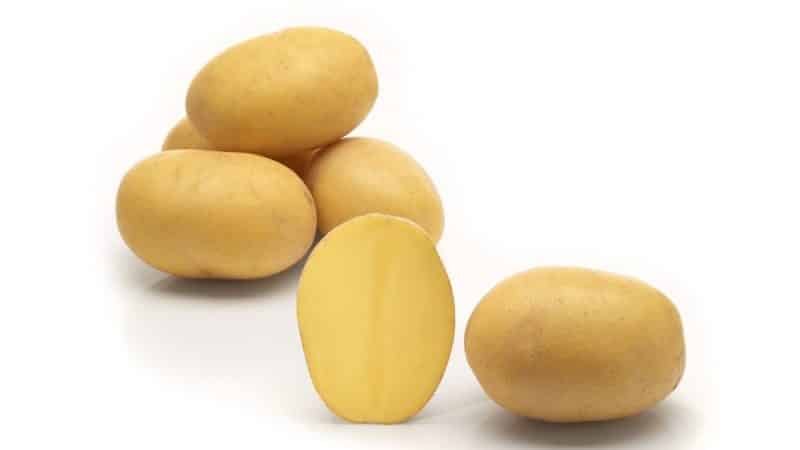
Origin and development
The variety was created by breeders of the German company Solana. In 2016, Lilly potatoes were included in the state register of breeding achievements.
Chemical composition, trace elements and vitamins
The tubers contain the following beneficial substances:
- folic acid;
- organic acids;
- phosphorus;
- iron;
- calcium;
- vitamins B, H, PP, D;
- potassium;
- cellulose;
- ascorbic acid;
- iodine.
The nutritional value of Lilly potatoes is 76 kcal per 100 g.
The variety is suitable for baby food, for people with diabetes, people with metabolic disorders and those suffering from diseases of the digestive system.
Characteristics of tubers, description of appearance and yield
Tubers are medium sized, uniform. They are convenient to clean, wash, and pack. The weight of one tuber is 100-150 g. The shape is most often round, sometimes oval. The peel is dense and elastic. The eyes are shallow.
Potatoes have excellent taste: they are buttery, crumbly, moderately sweet, in the process cooking does not disintegrate and does not change color. The average starch content is about 12%.
The yield is high: about 60-80 tons of potatoes are harvested from 1 hectare. The important thing is that to obtain such a high yield, a minimum amount of fertilizer is sufficient.
High yield is also evidenced by a high level of shelf life: potatoes can be stored for up to 9 months without losing their properties.
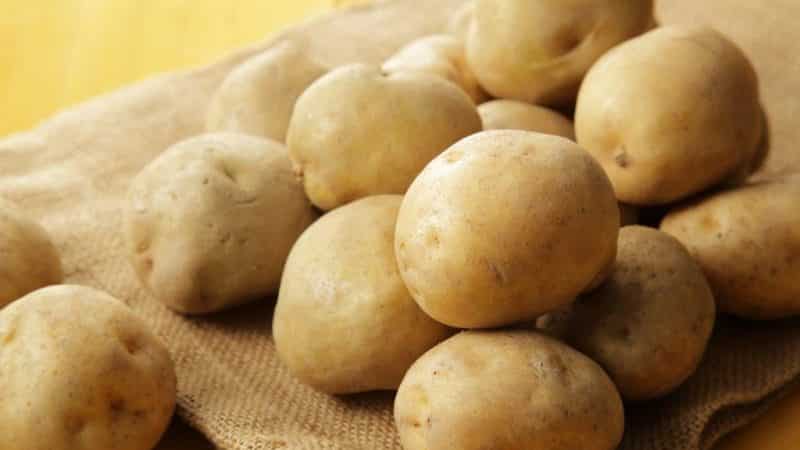
For which regions is it best suited?
Officially, the Lilly variety is recommended for planting in the following macroregions of Russia:
- Far Eastern;
- Northwestern;
- Middle Volga.
What is the difference from other varieties
Lilly is distinguished from most other potato varieties by its high yield, frost resistance, and waste-free use of tubers, which is possible due to their uniformity.
What is the difference with the variety with the consonant name Lileya
Lileya potatoes are a Belarusian variety. It also belongs to the category of yellow varieties, but it is an early crop, which is somewhat inferior to Lilly in terms of yield. In addition, Lilly is more resistant to common potato diseases.
The main advantages and disadvantages of the Lilly variety
The advantages of the variety include:
- high productivity;
- tubers do not change color for a long time after washing and cleaning;
- has immunity to common potato diseases: hollowness, rhizoctonia, scab, late blight, alternaria;
- resistant to rotten and rust;
- does not require large amounts of fertilizer;
- universal: suitable for baby and diet food;
- can be stored for a long time without loss of taste and presentation.
Disadvantages of the variety:
- high price;
- demanding on watering;
- Certain rules must be followed when planting.
Features of planting and growing varieties
Growing technique Lilly variety is similar to other varieties, but there are still some nuances.
Preparing for landing
Potatoes can be cut into pieces; it is advisable to dry them immediately before planting.
The site is prepared in advance. For Lilly, light loamy soil is preferred. It is advisable to plant in an area where beets, cucumbers, cabbage, and carrots previously grew. Acidic soil - deoxidize, fertilize with organic matter, dig up. In the spring, fertilizers containing phosphorus, potassium, and nitrogen are applied.
Dates, scheme and rules of planting
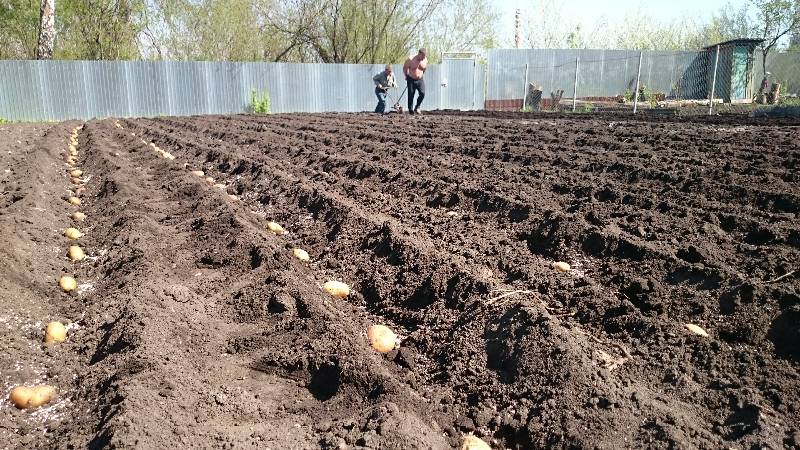
It is recommended to plant potatoes in May; the soil should warm up to +10°C. Holes are dug at least 10 cm deep.
Important condition. The rows should be even and the holes should be the same. It is recommended to add humus, ash, and complex fertilizer to the holes along with the potatoes.
Plant the tubers with the sprout facing down. Plants should be located at a large distance from each other (at least 60 cm), otherwise the tubers will be small.
It is advisable to arrange potato rows from north to south: with this arrangement, the potatoes will receive enough sunlight both in the morning and in the evening.
Features of cultivation
The Lilly variety is unpretentious to care. Standard measures are required: weeding, hilling, prevention of the Colorado potato beetle.
Nuances of care
The main feature of caring for Lilly potatoes is abundant and timely watering.
Watering mode
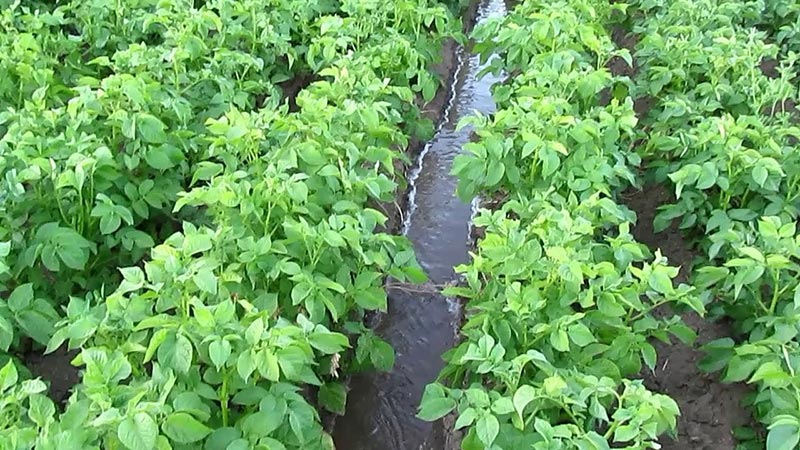
The Lilly variety needs watering throughout the growing season, especially during flowering. Water the plants at least once a week, preferably in the morning or evening. The water should be warm.
Top dressing
When planting, organic fertilizers - manure or bird droppings - are added to the holes. If desired, it can be replaced with mineral fertilizer with phosphorus and potassium (1 tsp of fertilizer per hole).
During the growing season, fertilizers containing superphosphates and potassium nitrate are applied 2-3 times.
Disease and pest control
The variety is resistant to most common potato diseases. Sometimes plants are affected by the fungal disease late blight.
Treatment and prevention consists of using chemicals according to the following scheme:
- The first treatment is carried out when the bush reaches a height of 20-30 cm. It is recommended to use copper sulfate and copper sulfate.
- Before potato flowering, plantings are treated with Epin and Exciol. If hot weather prevails, use Krezacin.
- For severe damage, use "Oxychom", "Ridomil". The treatment is repeated after two weeks.
- During the ripening period of the root crop, the plants are treated with the drug "Alyufit".
Lilly potatoes are susceptible to attack by the Colorado potato beetle, aphids, and mole crickets. To control pests, it is recommended to use the following drugs weekly: “Bitoxibacillin”, “Akarin”, “Fitoverm”, “Korado”, “Zubr”.
To prevent potato infection by diseases and pests, it is recommended to treat the seeds before planting with such preparations as: “Prestige”, “Epin”, “Bioglobin”.
Harvest and storage
Harvesting Lilly potatoes is similar to other potato varieties.
When and how to collect
Potatoes are dug 50-60 days after they are planted in the soil. The growing season may vary slightly depending on the weather conditions of the region.
The readiness of the fruit for harvesting is determined by the change in color of the tops - it should turn yellow.To facilitate the process of digging potatoes, the tops should be cut off 2-3 days before harvesting.
Storage features and keeping quality of the variety
It is recommended to dry the dug up potatoes. To do this, the tubers intended for food are poured onto the floor in a well-ventilated area. The potato layer should be no more than 20 centimeters. It is important that the floor is not concrete, preferably wooden. Dry the potatoes for at least 10 days, turning the tubers periodically. Seed potatoes can be dried in the sun.
Lilly has a high shelf life. In favorable conditions, potatoes can be stored for 9 months without losing their quality.
What difficulties may there be when growing
In general, the variety is unpretentious. Even inexperienced gardeners do not experience difficulties when growing them; the main thing is to give the potatoes enough watering and timely protect the plantings from diseases.
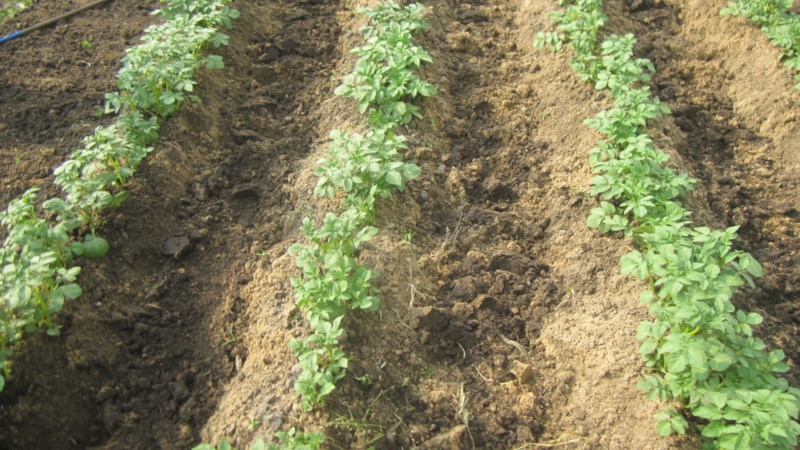
Advice from experienced gardeners and reviews about the Lilly variety
Below are reviews from experienced gardeners about Lilly potatoes.
Georgy, Pskov: «I learned about this potato variety from my neighbors. The price confused me at first - it was expensive, but I decided to buy it anyway. I didn’t regret it - I like potatoes: they’re tasty and don’t get soggy. And digging it up is a pleasure, because on each bush there are at least 10 large potatoes, small tubers are practically never found. Now I recommend Lilly’s potatoes to everyone.”
Maria, Tula: “Two years ago we planted Lilly potatoes for the first time as a test, several rows. We didn’t take into account that we needed to make a large distance between the rows and when harvesting we were disappointed - we came across small tubers, and the seller told us that like these potatoes only grow large. Then I read on the Internet how to plant it correctly.The next year we planted according to the scheme, and we were very pleased with the result - we harvested large, beautiful potatoes. Therefore, my advice is: follow all planting rules.”
Konstantin, Yoshkar-Ola: “A neighbor at the dacha recommended the Lilly variety; I had never heard of this before. I decided to buy it. As an experienced gardener, I know that each variety requires its own approach. I immediately learned from the seller how to properly plant and care for it. I fertilized the potatoes with manure according to the scheme, treated them against beetles, and watered them regularly. As a result, I harvested delicious yellow potatoes in the fall. I was very pleased."
Conclusion
Lilly potatoes have won the trust of many farmers. The variety is unpretentious; the main conditions for a high yield are proper planting and timely watering. The high cost of the variety easily pays for itself, because as a result, the gardener receives high-quality potatoes that store well and have excellent taste.